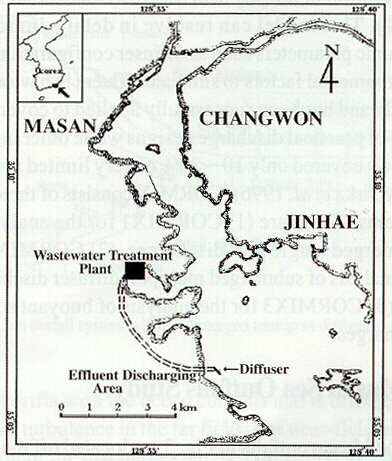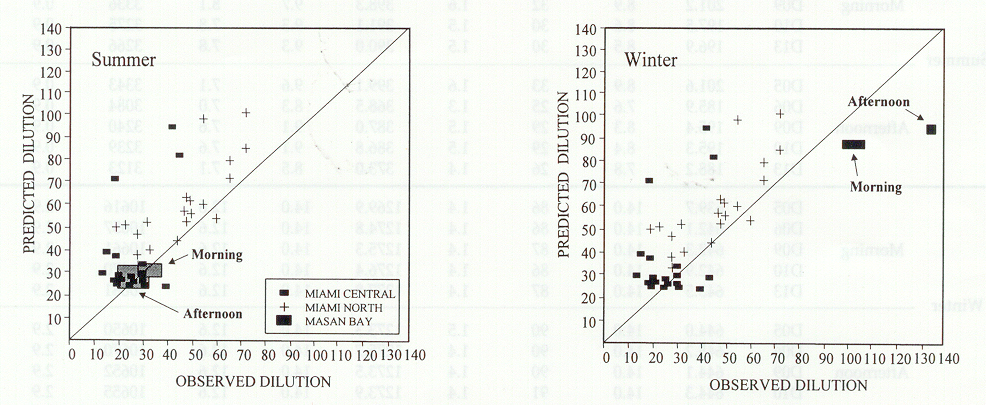

|
|
CORMIX Model Validations
|
This page contains information about independently conducted mixing zone studies
and CORMIX application in environmental impact analysis.
It is not intended to endorse or recommend any company, individual, or issue.
A dye study of mixing behavior in a stream.
|
Independent CORMIX Validation Studies:
- USEPA conducted a Science Advisory Board review of D-CORMIX (which is based upon CORMIX). This report concludes the model has the potential to predict mixing zone water quality from suspended sediment discharges and the methodology warrants additional development.
- The State of Idaho conducted a mixing zone evaluation and fish passage study for a surface mine drainage discharge into a small mountain stream. The report concludes relatively good agreement using v4.1 CORMIX3 model predictions when compared with field dye study data.
- The Department of Ecology in Washington State conducted a mixing zone model validation study in the Spokane River for a paper mill discharge. The report concludes that CORMIX2 model predictions compared well with field data.
- P.A. Davies, L.A. Mofor, and M.J. Neves found good overall agreement in CORMIX1 and CORMIX3 flow predictions with field data for cooling water discharges in "Comparisons of Remotely Sensed Observations with Modeling Predictions for the Behaviour of Wastewater Plumes from Coastal Discharges" International Journal of Remote Sensing, 1997, Vol. 18, No. 9, PP. 1987-2019. In particular the authors conclude that very good quantitative agreement between CORMIX predictions and field data can be found when water depths, discharge geometries, excess temperatures, and crossflow velocities are known with even moderate precision.
- I.K. Tsanis, C. Valeo, and Y. Diao report good near-field agreement in CORMIX2 predictions with available field data in "Comparison of Near-Field Mixing Models for Multiport Diffusers in the Great Lakes" in the Canadian Journal of Civil Engineering, Vol. 21. Feb. 1994.
- G.A. Kikkert, M.J. Davidson and R. I. Nokes, "Inclined Negatively Buoyant Discharges", Journal of Environmental Engineering, ASCE, Vol. 133, No. 5, pp. 545-554, May. 2007.
- In "Near-Field Mixing Characteristics of Submerged Effluent Discharges into Masan Bay" S.W. Kang et al. report overall agreement of CORMIX2 predictions with field dilution data for a wastewater outfall in a Korean estuary. They also make model prediction comparisons with field collected data from the Southeast Florida Ocean Outfall Experiment II (SEFLOE), in Ocean Research, Vol. 22 No. 1. pp. 45-56, 2000.

Masan Bay, Korea.
|

Predicted vs. Observed dilution for Masan Bay and SEFLOE
field experiments with CORMIX2 simulations.
|
- A. Etemad-Shahidi and A.H. Azimi - "Performance Of CORMIX Model Applied To Dense Jet Flow", XXXI IAHR CONGRESS 4211, September 11~16, 2005, Seoul, Korea
- A.H. Azimi, F. Azizi and A. Etemad-Shahidi, "A New Formulation to Estimate Initial Dilution of Dense Jet Flow", XXXI IAHR CONGRESS 4241,September 11~16, 2005, Seoul, Korea
- The book "Fundamentals of Environmental Discharge Modeling" (L. R. Davis, CRC Press, 1999) reviews several of the common methods used for prediction of initial mixing including an older DOS version of CORMIX. The author states in his recommendations "The major strength of the CORMIX models is in the ability to handle complex cases with boundary effects . . . if the other models don't apply or get into trouble, I use CORMIX" (page 145).
- In an another comparison of field data from the Southeast Florida Ocean Outfall Experiment II (SEFLOE), good agreement of CORMIX1 and CORMIX2 model predictions with field data are reported in "Comparison of Field Dilution Data with Model CORMIX" by P. Chandra in the Proceedings from the International Conference in Ocean Engineering COE '96, IIT, Madras India, 17-20 Dec. 1996.
- In an overview of environmental risks associated with offshore oil and gas industry discharges, R. Sadiq et al. find good agreement between CORMIX and a proposed far-field hydrodynamic model in "An Integrated Approach to Environmental Decision-making", presented at Canada-Brazil Oil & Gas HSE Seminar and Workshop, March 11-12, 2002.
- In a paper titled "Near-field Mixing at an Outfall", S.T. Gawad, J.A. McCorquodale, and H. Gerges find good agreement in CORMIX3 surface discharge dilution predictions with laboratory data in the Canadian Journal of Civil Engineering, Vol. 23. No. 1.,1996.
- In a detailed study of CORMIX3 surface discharge model predictions titled "Buoyant Surface Discharges Analysed by the Expert System CORMIX and Compared with Delft Hydraulics Laboratory Data Under Varying Flow Conditions", W. Summer, O. Schmidt and W. Zhang report satisfactory agreement over a wide range of flow conditions. Published in Hydroinformatics '94, Proceedings of the International Association for Hydraulic Research, Rotterdam; Balkema, Vol. 1, 1994.
- In another study of thermal wastewater plumes in lakes, C. Valeo I. Tsanis report general agreement of CORMIX2 predictions in coastal environments in "Two Case Studies of Dilution Models applied to Thermal Discharges" in the Canadian Journal of Civil Engineering, Vol. 23. 1996.
- C. Valeo, H. Shen, and I. Tsanis model a tributary mixing zone in Lake Ontario using CORMIX3 in both stratified and unstratified ambient conditions. They report good agreement with field data and another 3-D numerical hydrodynamic model results in "Modeling Mimico Creek as a Surface Discharge" in Journal of Hydraulic Research, Vol. 24, No. 1, 1996.
- Versar, Inc. conducted a validation study for the state of Maryland on the application of CORMIX3 version v3.2 to power plant discharges. Overall, model results were satisfactory for the 3 out 4 sites considered in the study, which included a large freshwater river, a narrow tidal estuary, a wide tidal estuary, and a wind-driven tidal estuary. This study highlights the limitations of methodology application where detailed hydrographic data is not available, where tidal currents and unsteady build-up over multiple tidal cycles can occur, and where wind-induced ambient currents affect plume trajectory and mixing.
- LMS Engineers conducted a water quality modeling study for the City of New York. Using CORMIX v2.1, overall they found good agreement in model predictions of initial dilution with data from 12 separate outfall dye studies, and make recommendations for model application. There results are reported in "CORMIX Model Nearfield Dilution Evaluations for 12 Water Pollution Control Plant Discharges," by D. Distante, R. O'Neill, G. Apicella, and H. Tipping, in WEFTEC '94 Vol 4; Surface Water Quality and Ecology, Annual Conference and Exposition-Water Environment Federation; Conf 67; VOL 4. 1994.
- A University of Western Australia thesis outlines application of CORMIX2 version v2.1 to wastewater discharge in a marine environment. Model results were in good to fair agreement with near-field dilution data.
- A University of British Columbia thesis outlines the application of CORMIX1 version v3.1 to paper mill effluents. A combination of laboratory experiments and field data found that model predictions produced reasonable results.
- In a paper by K.L. Pun and M.J. Davidson titled "On the Behaviour of Advected Plumes and Thermals", Journal of Hydraulic Research, Vol. 37, No. 4, 1999, the authors state that CORMIX1 provides reasonably accurate predictions of wastewater behavior in the ocean.
- A comparison of various simulation models for thermal plume assessment is given in his paper by A. C. Pinheiro and J. P. Ortiz. The authors state that "(CORMIX ) . . . is accepted internationally as a good tool to provide information . . . (on) water field temperature."
-
Loya-Fernandez, Angel & Ferrero-Vicente, Luis & Marco-Mendez, Candela & Martinez-Garcia, Elena & Zubcoff, Jose & Sanchez Lizaso, Jose. (2017).
"Quantifying the efficiency of a mono-port diffuser in the dispersion of brine discharges". Desalination. 10.1016/j.desal.2017.11.014.
|
|

